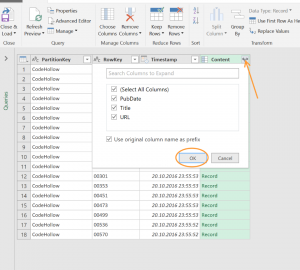
- #Azure data studio add column to table install#
- #Azure data studio add column to table manual#
- #Azure data studio add column to table professional#
- #Azure data studio add column to table windows#
Let us now create a dev database from the production database using the DACPAC file that contains the structure of the database.Ĭlick the Connections icon on the left navigation bar (if you have not already opened it) and right-click on theĭatabases folder followed by clicking Data-tier Application wizard: In less than a minute or so the database DACPAC file is ready, saved in the desired location.ĭeploying Production Database DACPAC to Create Dev Database In the final step, click on the Extract button: One very important point to be mentioned here that since DACPAC only contains the structure of the database so there is no concern of data privacy as no data will be transferred to the dev environment through this.
#Azure data studio add column to table professional#
Select the location where you would like to preserve (save) the DACPAC file and click Next:ĭo remember this location is vital and in a professional life scenario, it can be a shared storage accessible by all the team. Now select the second option in the next which says Extract a data-tier application from an instance of SQL Server to a DACPAC file followed by clicking Next: Right-click on SQLSampleBooks _Prod and click Data-tier Application wizard: Now once we have the production database sample, the next step is to extract and preserve the DACPAC of this database and this is where the DACPAC extension comes into action. Script against the master database while connected to the local/remote SQL Server instance in Azure Data Studio:Įxtracting and Preserving DACPAC of the Production Database The first step in this regard is to replicate the production database.Ĭreate a sample database called BooksSample_Prod in Azure Data Studio by running the following Manner without any external interference. There may be many reasons for this (having a production database without a dev database) and it is fine to have suchĪ situation although in a typical database development scenario we normally do not expect a dev database without aĭACPAC extension can help us to solve this problem (of creating a fresh dev database) in a very safe and sound This is not a very common scenario for a database developer or DBA or even for a database infrastructure engineer who has a production database but wants to set up a dev database for the developers to work on. We must create a fresh dev database complying with the most recent production database structure. Scenario: Creating Dev Database from Production Database Let us understand the use of this handy extension in the light of a professional life scenario. We are good to go as the next step is to use the extension to see how it works particularly in the context of You should be able to locate a new option “Data-tier Application wizard”: Once connected right click on the connected Server to bring up the context menu. Now, switch to the Connections and connect to your local/remote SQL Server instance.

#Azure data studio add column to table install#
Please click the Install button to begin the installation. Please open Azure Data Studio and switch to Extensions.Īs soon as you type “SQL server dacpac” in the search box you are going to see the desired extension appearing in In order to use the extension, we have to install it first, so let us do that. (through DACPAC packages) that is going to help us to simplify the DLM (Database Lifecycle Management). In simple words, we can use this extension in Azure Data Studio to manage specific database deployments strategy

The database must be registered as a data-tier application to be managed via standard DACPAC deployments in a
#Azure data studio add column to table manual#
Responsible for deploying the database to target environments in a manual or automated fashion.Īre there any requirements for standard data-tier application management via DACPAC?

#Azure data studio add column to table windows#
This extension helps in database import and export operations primarily built for managing data-tier applications.Īccording to Microsoft documentation, a data-tier application is a logical database management entity that definesĪll the SQL Server objects like tables, views associated with a user’s database.Ī DACPAC is a data-tier application package in the form of a windows file containing all the database structure intoĭACPAC helps developers and DBAs to package their database into a single unit to be either handed over to the team It is always good to first get familiar with this extension before we start installing and using it.

At the end of the article, you will also find some handy tips about the approach supported by this extension. This article is focused on installing and using SQL Server DACPAC Extension in Azure Data Studio.Īdditionally, the readers of this article are going to get a conceptual understanding of this extension along with its implementation in the light of a professional life scenario.


 0 kommentar(er)
0 kommentar(er)
